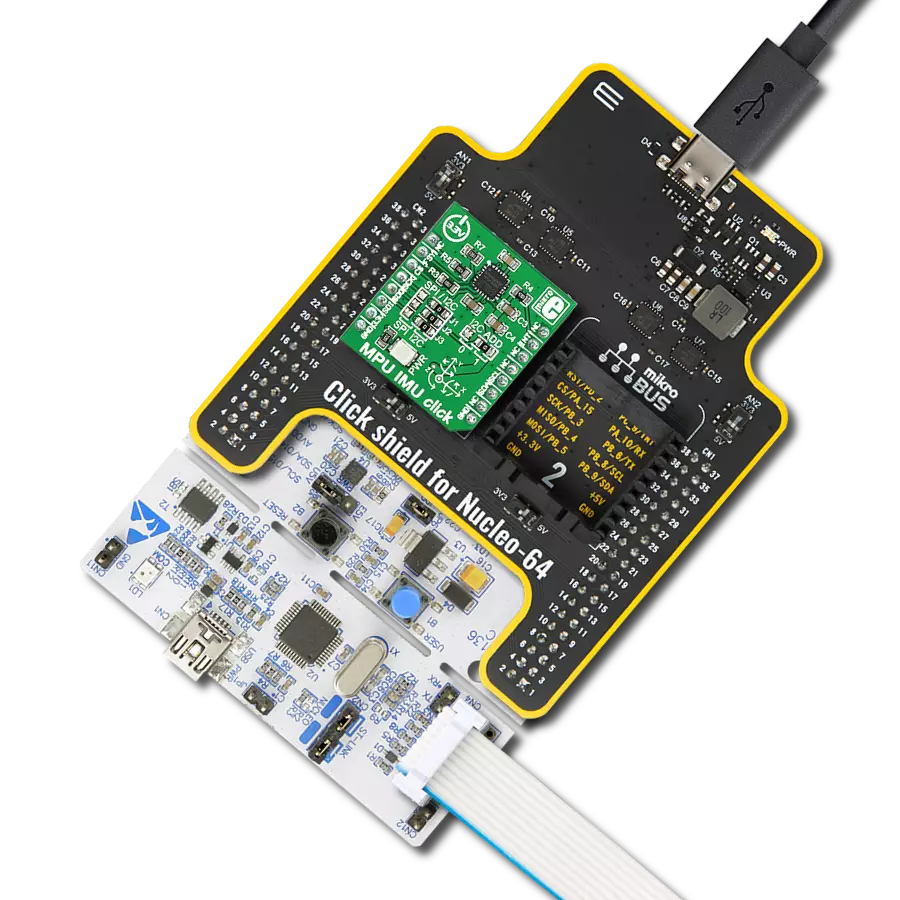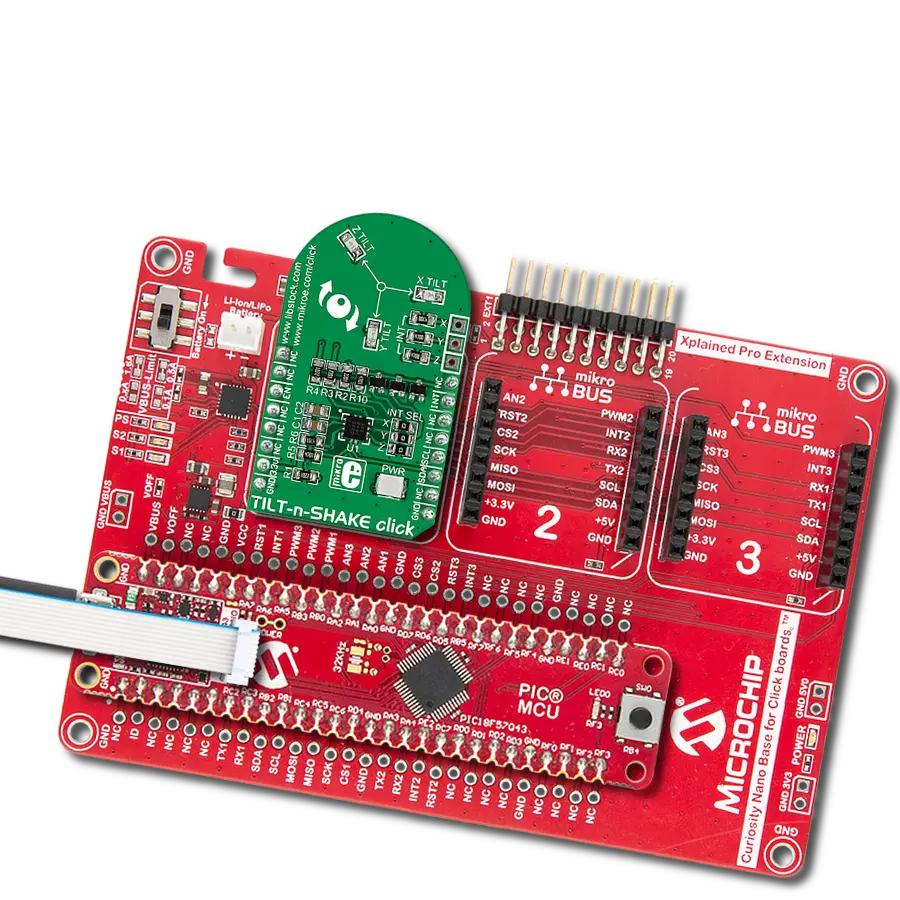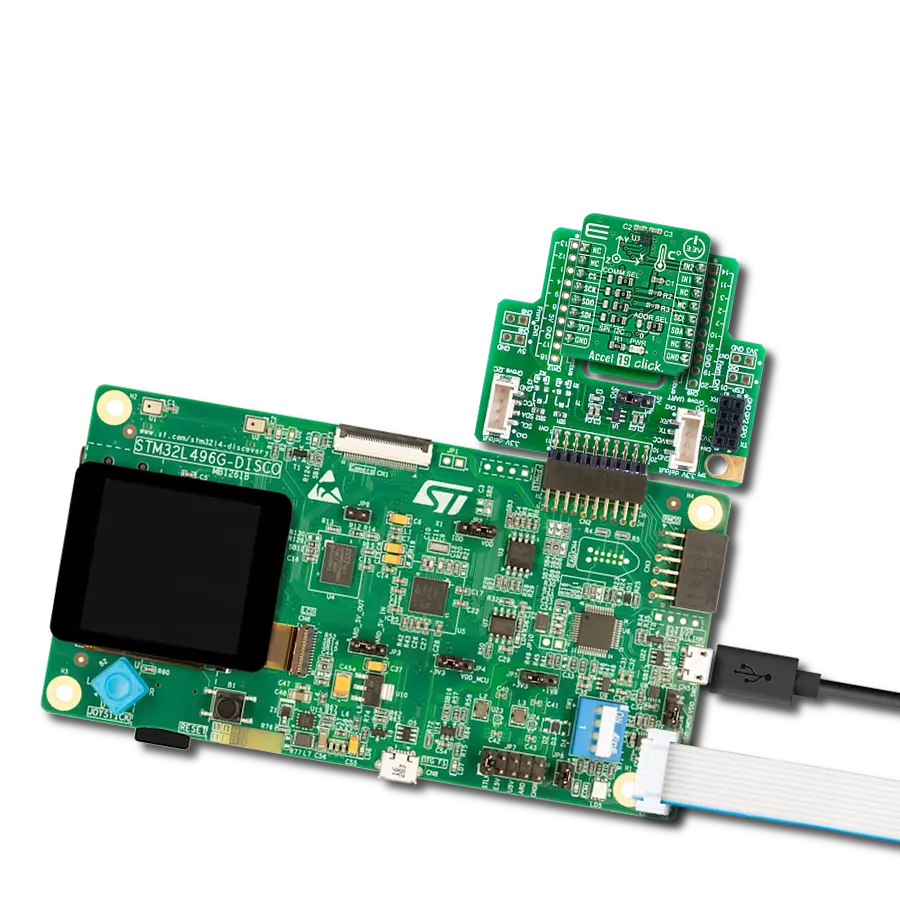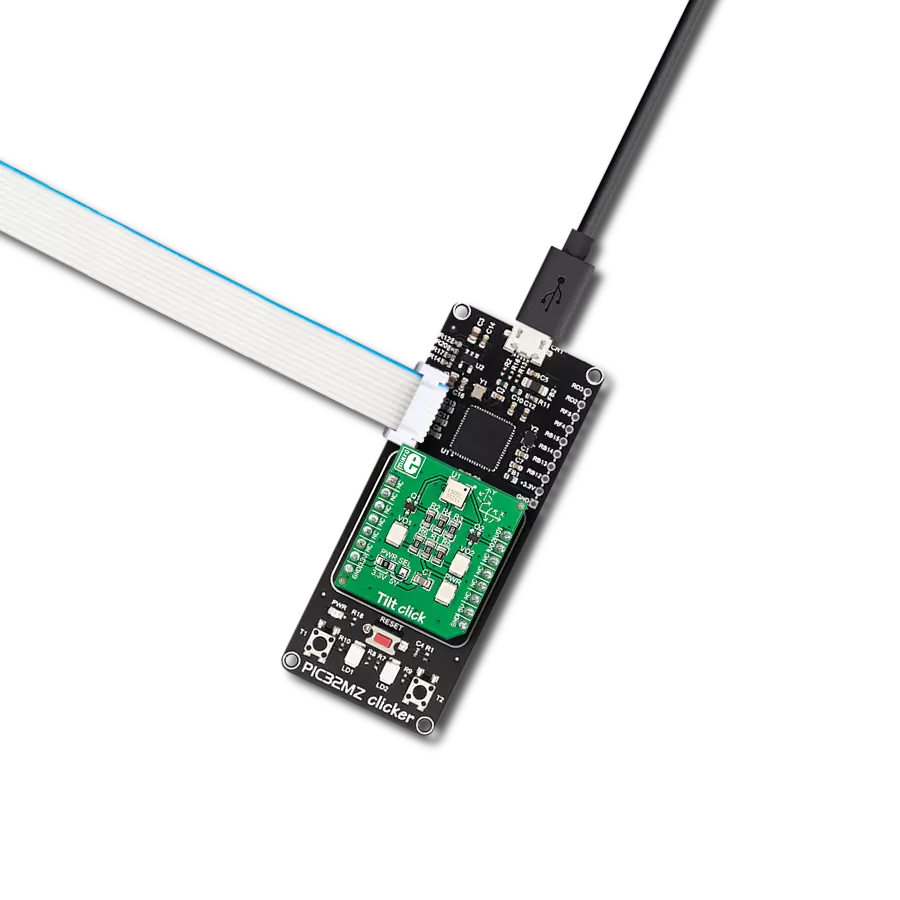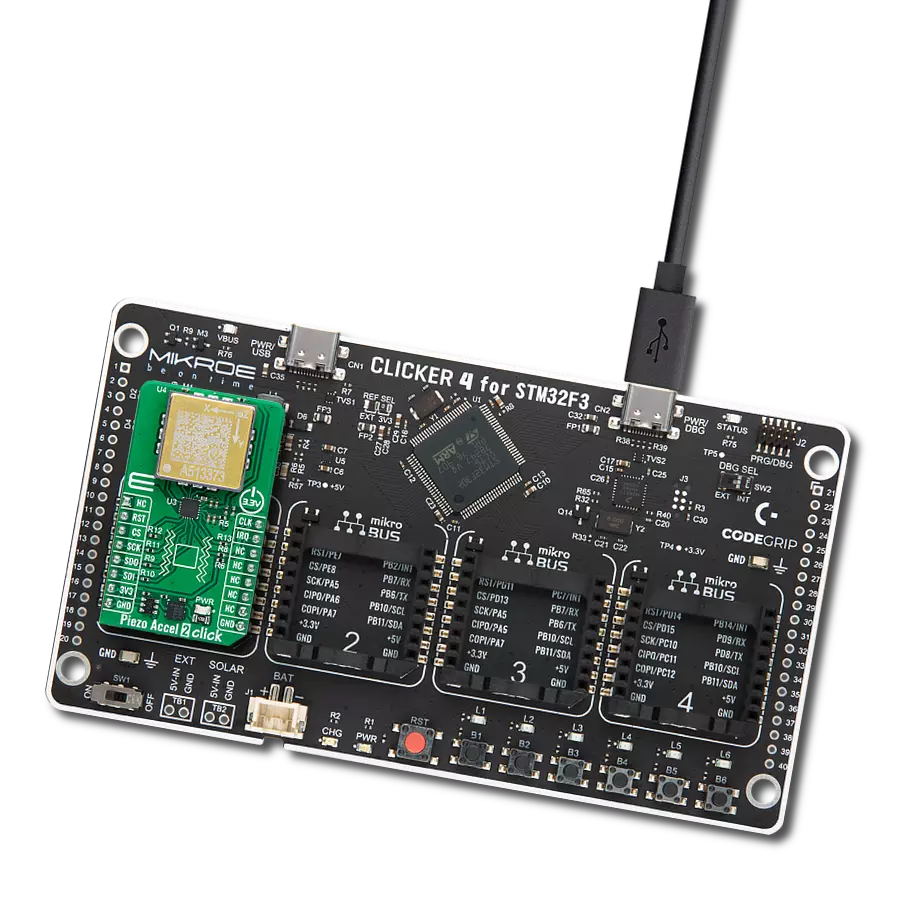Unlock a realm of possibilities with our 9DOF low-power solution, where motion and magnetometer capabilities unite to redefine what's achievable in efficiency-driven applications without sacrificing the accuracy you demand
A
A
Hardware Overview
How does it work?
9DOF 2 Click is based on the ICM-20948, a high performance, 9-axis MotionTracking™ IC from TDK Invensense. ICM-20948 also supports an auxiliary I2C interface to external sensors, which offers greater system flexibility. The output of each MEMS is processed and digitized by a separate sigma-delta 16-bit A/D converter (ADC). Three-axis gyroscope MEMS can be programmed to measure the rotation about each axis in four different ranges of rotational speed (degrees per angle, DPS): ±250, ±500, ±1000, and ±2000. Three-axis accelerometer MEMS can be programmed to measure the acceleration along each axis in four different acceleration ranges: ±2g, ±4g, ±8g, and ±16g. Three-axis magnetometer can do a full-scale measurement of ±4900 µT. Interrupt functionality is configured via the Interrupt Configuration register. Configurable items include the INT
pin configuration, the interrupt latching and clearing method, and triggers for the interrupt. The interrupt is routed to the INT pin of the mikroBUS™. A FIFO buffer helps to reduce the processing load further, offering temporary storage for the output data. The ICM-20948 contains a FIFO of size 512 bytes (FIFO size will vary depending on the DMP feature-set) accessible via the Serial Interface. The FIFO configuration register determines which data is written into the FIFO. Possible choices include gyro data, accelerometer data, temperature readings, auxiliary sensor readings, and FSYNC input. Synchronization with an external digital signal is possible over the FSYNC pin. This pin is routed to the PWM pin of the mikroBUS™, labeled as SNC. The embedded Digital Motion Processor (DMP) within the ICM-20948 offloads computation of
motion processing algorithms from the host processor. The DMP acquires data from accelerometers, gyroscopes, and additional third-party sensors such as magnetometers and processes the data. The resulting data can be read from the FIFO. The DMP has access to the external pins, which can be used for generating interrupts. ICM-20948 supports SPI and I2C communication interfaces, but only the SPI interface is used on the 9DOF 2 Click. The TXB0108 bidirectional voltage level translator converts the voltage level between ICM-20948 and 3.3V MCU. This Click Board™ uses only the SPI communication interface. It is designed to be operated only with 3.3V logic levels. A proper logic voltage level conversion should be performed before the Click board™ is used with MCUs with logic levels of 5V.
Features overview
Development board
Nucleo 32 with STM32F031K6 MCU board provides an affordable and flexible platform for experimenting with STM32 microcontrollers in 32-pin packages. Featuring Arduino™ Nano connectivity, it allows easy expansion with specialized shields, while being mbed-enabled for seamless integration with online resources. The
board includes an on-board ST-LINK/V2-1 debugger/programmer, supporting USB reenumeration with three interfaces: Virtual Com port, mass storage, and debug port. It offers a flexible power supply through either USB VBUS or an external source. Additionally, it includes three LEDs (LD1 for USB communication, LD2 for power,
and LD3 as a user LED) and a reset push button. The STM32 Nucleo-32 board is supported by various Integrated Development Environments (IDEs) such as IAR™, Keil®, and GCC-based IDEs like AC6 SW4STM32, making it a versatile tool for developers.
Microcontroller Overview
MCU Card / MCU

Architecture
ARM Cortex-M0
MCU Memory (KB)
32
Silicon Vendor
STMicroelectronics
Pin count
32
RAM (Bytes)
4096
You complete me!
Accessories
Click Shield for Nucleo-32 is the perfect way to expand your development board's functionalities with STM32 Nucleo-32 pinout. The Click Shield for Nucleo-32 provides two mikroBUS™ sockets to add any functionality from our ever-growing range of Click boards™. We are fully stocked with everything, from sensors and WiFi transceivers to motor control and audio amplifiers. The Click Shield for Nucleo-32 is compatible with the STM32 Nucleo-32 board, providing an affordable and flexible way for users to try out new ideas and quickly create prototypes with any STM32 microcontrollers, choosing from the various combinations of performance, power consumption, and features. The STM32 Nucleo-32 boards do not require any separate probe as they integrate the ST-LINK/V2-1 debugger/programmer and come with the STM32 comprehensive software HAL library and various packaged software examples. This development platform provides users with an effortless and common way to combine the STM32 Nucleo-32 footprint compatible board with their favorite Click boards™ in their upcoming projects.
Used MCU Pins
mikroBUS™ mapper
Take a closer look
Click board™ Schematic

Step by step
Project assembly
Track your results in real time
Application Output
1. Application Output - In Debug mode, the 'Application Output' window enables real-time data monitoring, offering direct insight into execution results. Ensure proper data display by configuring the environment correctly using the provided tutorial.

2. UART Terminal - Use the UART Terminal to monitor data transmission via a USB to UART converter, allowing direct communication between the Click board™ and your development system. Configure the baud rate and other serial settings according to your project's requirements to ensure proper functionality. For step-by-step setup instructions, refer to the provided tutorial.

3. Plot Output - The Plot feature offers a powerful way to visualize real-time sensor data, enabling trend analysis, debugging, and comparison of multiple data points. To set it up correctly, follow the provided tutorial, which includes a step-by-step example of using the Plot feature to display Click board™ readings. To use the Plot feature in your code, use the function: plot(*insert_graph_name*, variable_name);. This is a general format, and it is up to the user to replace 'insert_graph_name' with the actual graph name and 'variable_name' with the parameter to be displayed.

Software Support
Library Description
This library contains API for 9DOF 2 Click driver.
Key functions:
c9dof2_power- Turns the device on or offc9dof2_read_gyroscope- This function is used to read gyroscope datac9dof2_read_accelerometer- This function is used to read accelerometer data
Open Source
Code example
The complete application code and a ready-to-use project are available through the NECTO Studio Package Manager for direct installation in the NECTO Studio. The application code can also be found on the MIKROE GitHub account.
/*!
* \file
* \brief 9dof2 Click example
*
* # Description
* This example demonstrates the use of 9DOF 2 Click board.
*
* The demo application is composed of two sections :
*
* ## Application Init
* Initalizes SPI and device drivers, performs safety check,
* applies default configuration and writes an initial log.
*
* ## Application Task
* Reads the angular and acceleration rates and displays the values of X, Y, and Z axis
* on the USB UART each second.
*
* \author MikroE Team
*
*/
// ------------------------------------------------------------------- INCLUDES
#include "board.h"
#include "log.h"
#include "c9dof2.h"
// ------------------------------------------------------------------ VARIABLES
static c9dof2_t c9dof2;
static log_t logger;
uint8_t id_val;
float x_accel;
float y_accel;
float z_accel;
float x_gyro;
float y_gyro;
float z_gyro;
// ------------------------------------------------------ APPLICATION FUNCTIONS
void application_init ( void )
{
log_cfg_t log_cfg;
c9dof2_cfg_t cfg;
/**
* Logger initialization.
* Default baud rate: 115200
* Default log level: LOG_LEVEL_DEBUG
* @note If USB_UART_RX and USB_UART_TX
* are defined as HAL_PIN_NC, you will
* need to define them manually for log to work.
* See @b LOG_MAP_USB_UART macro definition for detailed explanation.
*/
LOG_MAP_USB_UART( log_cfg );
log_init( &logger, &log_cfg );
log_info( &logger, "---- Application Init ----" );
// Click initialization.
c9dof2_cfg_setup( &cfg );
C9DOF2_MAP_MIKROBUS( cfg, MIKROBUS_1 );
c9dof2_init( &c9dof2, &cfg );
c9dof2_dev_rst( &c9dof2 );
Delay_ms ( 1000 );
id_val = c9dof2_read_byte ( &c9dof2, C9DOF2_WHO_AM_I_ICM20948 );
if ( id_val == C9DOF2_WHO_AM_I_ICM20948_VAL )
{
log_printf( &logger, "--------------------\r\n" );
log_printf( &logger, " 9DOF 2 Click \r\n" );
log_printf( &logger, "--------------------\r\n" );
c9dof2_power ( &c9dof2, C9DOF2_POWER_ON );
}
else
{
log_printf( &logger, "--------------------\r\n" );
log_printf( &logger, " FATAL ERROR!!! \r\n" );
log_printf( &logger, "--------------------\r\n" );
for ( ; ; );
}
c9dof2_def_settings( &c9dof2 );
log_printf( &logger, "--- Initialised ---\r\n" );
log_printf( &logger, "--------------------\r\n" );
Delay_ms ( 1000 );
}
void application_task ( void )
{
// Task implementation.
c9dof2_angular_rate( &c9dof2, &x_gyro, &y_gyro, &z_gyro );
log_printf( &logger, "Angular rate: \r\n" );
log_printf( &logger, "X-axis: %.2f \r\n", x_gyro );
log_printf( &logger, "Y-axis: %.2f \r\n", y_gyro );
log_printf( &logger, "Z-axis: %.2f \r\n", z_gyro );
log_printf( &logger, "---------------------\r\n" );
c9dof2_acceleration_rate( &c9dof2, &x_accel, &y_accel, &z_accel );
log_printf( &logger, "Acceleration rate: \r\n" );
log_printf( &logger, "X-axis: %.2f \r\n", x_accel );
log_printf( &logger, "Y-axis: %.2f \r\n", y_accel );
log_printf( &logger, "Z-axis: %.2f \r\n", z_accel );
log_printf( &logger, "---------------------\r\n" );
Delay_ms ( 1000 );
}
int main ( void )
{
/* Do not remove this line or clock might not be set correctly. */
#ifdef PREINIT_SUPPORTED
preinit();
#endif
application_init( );
for ( ; ; )
{
application_task( );
}
return 0;
}
// ------------------------------------------------------------------------ END
Additional Support
Resources
Category:Motion





















